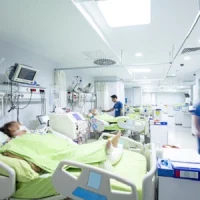Smooth clinical operations of a facility are based on the adequate and consistent availability of staff, space, equipment, and a coordination mechanism. However, under acute surge events such as local epidemics or pandemics like the ongoing COVID-19, healthcare facilities may consider a viable preparedness plan.
Staff capacity, both clinical and support, can be threatened either by higher patient volume or staff getting sick themselves, staying home to look after family such as when schools/daycare centers are closed. This can be overcome by ensuring existing staff stays safe through optimising infection control, recalling off duty/retired staff, cancelling staff vacations, calling in staff to work in areas closely related to their training such as hospitalists caring for the critically ill, and providing support staff for “just-in-time” task-specific training. A pool of volunteers should be identified, including a training plan to maintain health care standards.
Space or bed capacity is the physical space required for patient care, which can be threatened during periods of high patient volume or patients requiring isolation units. Some ways to overcome this issue is to use ward beds for intensive care, cancelling elective surgeries, and earlier discharge for less acute patients.
Threats to equipment include higher patient acuity which increases the demand for routine equipment such as mechanical ventilators; disruption in medicine supply chains leading to a shortage of sedatives or antibiotics; increased wait time for available CT scanners to have them disinfected between patients; and increased demand for personal protective gear, PPE. This can be overcome by efficient use of existing stock, and where possible, carefully repurposing equipment and reusing single-use items.
Coordination of operations also needs to have a preparedness plan to optimise efforts and resources. A focal person should be identified who can oversee coordination efforts internally as well as liaise with local, state, or national authorities to mobilise support. A robust communication plan will be a key success factor.
Development and continued reassessment of disease case definitions will determine the overall impact on the system operations. For example: which patients should be sent for diagnostic testing; what kind of protective gear should be used; what isolation practices should be in place to avoid the spread of a pathogen; how should patients with negative results be cared for; and how should resources (staff/equipment) attached to patient with negative results be reallocated. It can help to cohort patients to a single location that helps concentrate required equipment and personnel and decreases the risk of transmission. An added benefit is that the staff involved in this exercise can gain expertise in the use of newly designed clinical protocols and the use of PPE.
Last but not the least is the human side of surge planning. Reassignment and/or opt-out of personnel who are either sole caregivers in the family or pregnant or have a personal discomfort with the risk of transmission should be considered. A mechanism to monitor the symptoms of health personnel should be devised early on.
Health emergencies of large scale may require a shift from the norm in order to a care model that will do the most good for the most people.
Source: Critical Care Explorations
Image Credit: iStock
References:
George A, Ylinne L, Laura E (2020) A Conceptual and Adaptable Approach to Hospital Preparedness for Acute Surge Events Due to Emerging Infectious Diseases. Critical Care Explorations, 2(4):e0110. doi: 10.1097/CCE.0000000000000110
Latest Articles
Hospitals, COVID-19, preparedness
Adaptable Approach to Hospital Preparedness for Acute Surge Events










